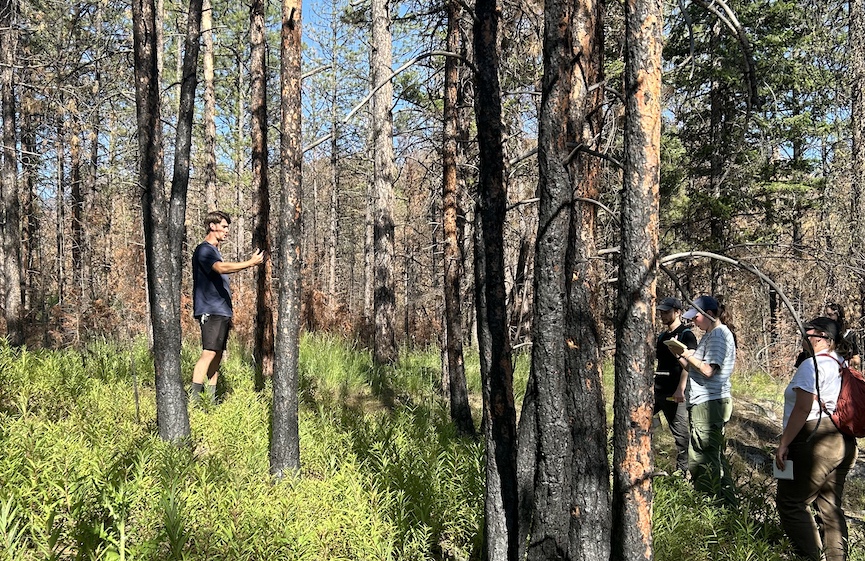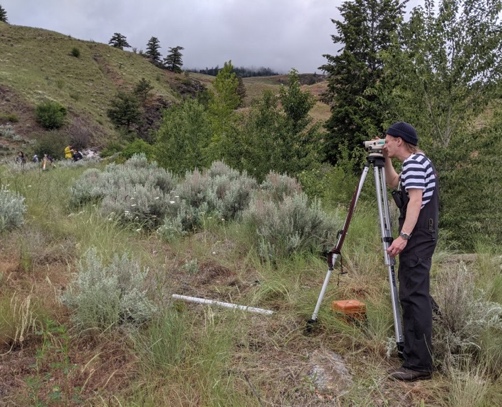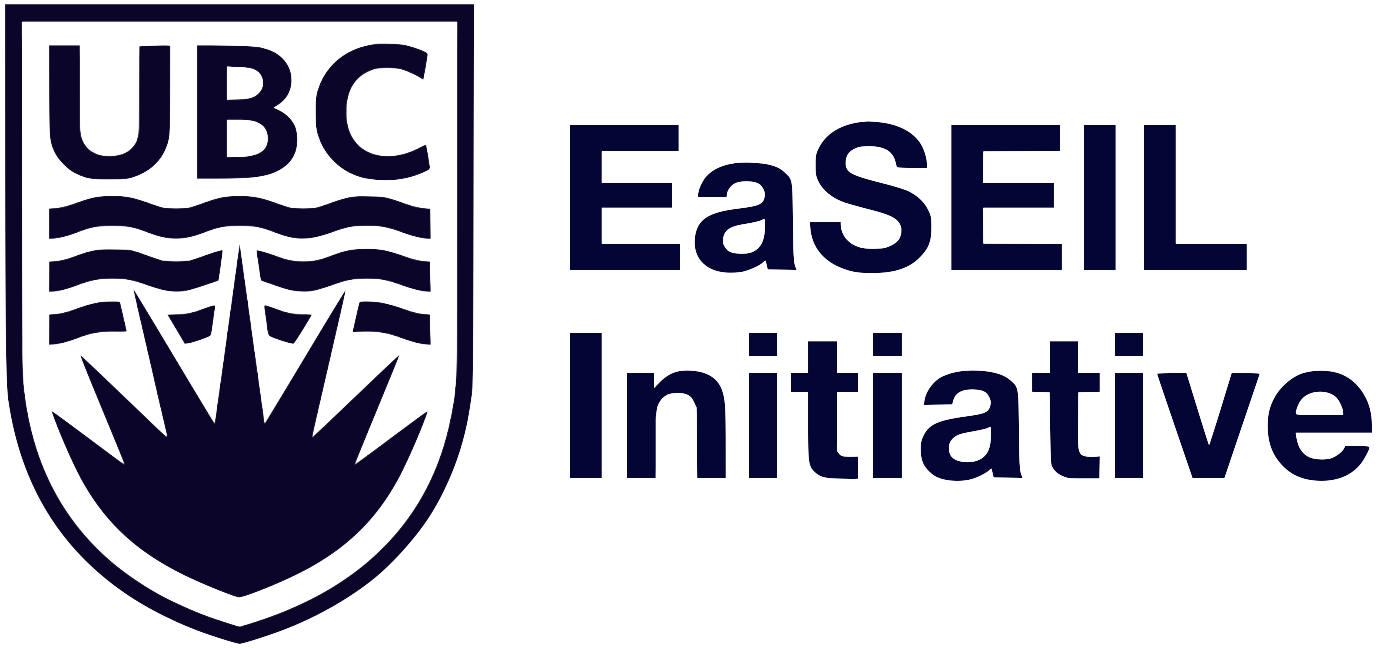Geographical Sciences Field Course (GEOS 309)
Instructors involved in EaSEIL
Nina Hewitt and Brett Eaton* (Course Designers and Instructors)
*Instructor from 2022 to 2024
Context: Course Description
Level: 3rd year
Credits: 3
Term: Summer
Capacity: ~25 students
Additional fees (2024-2025): $ 1195 (transportation, meals, accommodation)
Instructional team: 2 instructors, 2 teaching assistants
This is a multi-day course (~11 days) held in late May-early June at the UBC-Teck Geological Field Station (Syilx Lands – Oliver, British Columbia, Canada) with day trips to various field sites in the local area.
Note: GEOS 309 was first taught on this location in the Summer of 2022.

Overarching Learning Goals
This course builds student knowledge and skills on the basic methods/techniques of field work in geographical sciences including surveying and mapping, field sampling, instrumentation, electronic data acquisition, and the design and implementation of field projects. Students engage in peer-to peer and student-to-instructor learning.
Typical Schedule and Activities
Prior to Field Course
2 required meetings (1.5 hours each) to prepare for field week. Meeting 1 (virtual): Meet-n-greet, review safety procedures and equipment needs; and Google Earth mapping exercise. Meeting 2 (hybrid/mandatory): short lesson, overview of safety, travel arrangements.
Pre-requisite mandatory forms (signed code of conduct; emergency medical and diet information) and safety training (Heat stress awareness online course).
During
Field Course
(11 days; 8-5 pm)
Day trips in the area, guest-lectures/workshops with community as co-educators. Opportunities to practice survey, data collection, field observation, sketching, note taking. Daily field assignments (individual reflections/write ups, field notes, summaries, sketches; 3 group technical reports).
Other
Breakfast and dinner at the field station, packed lunch for field day.

observation via landform sketches1


1Photo Credits: Nina Hewitt, 2022
Curricular Development
Goals (G) and Motivation
G1: To offer a place-based, contextually grounded and cooperative field experience that includes voices, Knowledges and perspectives of local Indigenous and non-Indigenous community members as co-educators. This goal recognizes local community connections to and knowledge about the land, adding knowledge that we (instructors) cannot supply. The objectives were to:
-
a. Enhance student and instructor cultural awareness and knowledge about local Indigenous communities and honour their perspectives, Land rights, cultural and historical legacies;


Cultural Centre1
1Photo Credits: Nina Hewitt, 2023
- Enhance student knowledge about regenerative farming; FireSmartBC practices; local grassland ecology and soils; river restoration and management; and geomorphic/landform processes.

Workshop at Covert Farms1

ecology, Daniel Robinson, demonstrates a
jackstraw stand2

management workshop that informs annual
fire hazard assessment GEOS 309 does at the
UBC-Teck Geological Field Station2

Restoration Initiative delegate, Zoe Eyjolfson,
teaches about River restoration and channel
features3
Photo Credits: Nina Hewitt 12022; 22023; 32024
G2: To develop accessible activities that build on field techniques in Geosciences and teach skills of soils, vegetation and landform interpretation and exploration pertinent to new field location



Debris flow landform analysis; soils activity on a local landowner’s property. Photo credits: Nina Hewitt, 2023
G3: To enhance inclusion and accessibility by adding approaches that make the course more accommodating for a diverse array of students and building a sense of belonging prior to the course
| Activities | 2022-2023 | 2023-2024 (Ongoing) |
|---|---|---|
| Prior to Field School | G1: New Land acknowledgement in syllabus, established and continued building reciprocal relationship with local community members, pre-field assignments about nsyilxcən language (designed by co-educator J. cnúk Bower – Nk’Mip Desert Cultural Centre) | |
| G2: Implemented New pre-field mapping exercise to introduce students to local Okanagan geomorphology and included information of local and Indigenous place names G3: New short activities in pre-field meetings to establish peer connections, introduce pronouns; offered Virtual tour of the UBC-Teck Geological Field Station to prepare students for field week so they could focus on learning |
||
| During Field School | G1: Visit to Nk’Mip Cultural Desert Centre (optional ‘22, embedded in course as of ’23; tailored to course as of ‘24); research sensitivity & language revitalization with J. c. Bower (co-educator) plus reflection (this activity did not happen in 2024 or 2025 due to limited time and funding, and the addition of an experience with Okanagan Nation Alliance, below) G2: 3 new local community members as co-educators – workshops/guest lectures/activities |
|
| G1&G2: New local community member as co-educator (Okanagan Nation Alliance Representative) to learn about the Okanagan River Restoration Initiative (ORRI) in the field G2: Changed focus of/extended with applied activities some guest lectures, re-connected with landowner to access their land for study G3: Collaborated with students to create sleeping arrangement, changed language to refer to groups (diverse not co-ed) |
||
Note: For a detailed description of Goal 1 and related activities, refer to:
Hewitt, N., Mazabel,S., Lukes,L., Eaton,B., Bower, J. cnúk. (2025). Fostering a sense of place and partnership in geoscience field education with Indigenous and other communities. In J. E. Wessell (Ed.), Experiential Learning in Geography II: The World as our Classroom (pp. 45-60). Springer Nature. http://doi.org/10.1007/978-3-031-82575-0
Impact
Students
Total number of students enrolled 2022-2025 (four course offerings): 86 undergraduate students, plus 5 MSc students (the latter choose it to expand their field techniques and obtain credit toward Engineering Geoscientists of BC certification)
Students enrolled in GEOS 309 Summer 2024 (n=21) completed an online anonymous survey at the end of the course. They were asked to share with instructors about their experience in sessions with community members as co-educators in which speakers shared knowledge, experiences and perspectives relevant to the subject of study. More details in forthcoming publications/presentations.
“This was an excellent class and I would recommend it to all students in the environment/geography disciplines. The breadth of opportunities presented in just 11 days allowed me to pick up so much knowledge and skills, make long–lasting connections with peers in my discipline, and also figure out which area of geoscience I was most interested in and continue pursuing courses in said areas. I also enjoyed the focus group I felt that was a pretty exciting way to get involved in the department.” [The focus group was about updates to the BSc program in Geography of which GEOS 309 is a capstone course] (anonymous student comment in Student Evaluation of Teaching Survey, 2025 – shared by instructor on July 11, 2025)
Instructors’ Reflections
“The students said the community engaged aspect was really important to them, because they heard from people that loved the place and had managed to deal with the wildfire risks in particular ways, and even embrace them.” [Instructor reflective interview, Aug.’23]
[The virtual tour of the field station] “It was clear to me that some students had done it and used it and that it was helpful because they were saying things that came out of that” (Instructor reflective interview, Aug.’ 24)
“One of the most important things about field camps is those peer-to-peer relationships” (Instructor reflective interview, Aug.’23) … “[The students] were able to have an introduction with 3 or 4 different people [in the meet-n-greet pre-field activity], I think it was nice, it contributed to an atmosphere that this is about peer connections” (Instructor reflective interview, Aug.’ 24)
“Partnering with community members as co-educators contributed to student understanding of professional competencies relevant in the field of study such as fire ecology and management; viticulture and sustainable farming; and in forging meaningful, reciprocal relationships with Indigenous and other non-Indigenous communities. Students built an appreciation of the importance of including multiple perspectives to understand topics of interest, and of the value of learning from those with lived experience in the place of study.” (Instructors, Advancing Community Engaged Learning Final Report, Nov.’23)
“Another surprising outcome of partnering with community members as co-educators was its role in reshaping the co-instructor perspectives on field camp. Traditionally, geographical sciences field camps have tended to revolve around rather western forms of engagement with place – instrumentation, measurement and other approaches that treat the space as an object of study. Thus, by reaching out and engaging with local peoples, we learned that there was more to the space than we could uncover with our field methods, when viewed through the lens of those who call it home; We did not only enhance our cultural awareness and knowledge about local Indigenous communities, in terms of language and ecology and values, we also witnessed the power of community storytelling as a means to decolonize field-teaching practices.” (Instructors, Advancing Community Engaged Learning Final Report, Nov.’23)
Key Lessons Learned
- These field-based courses are very invaluable to students for peer-peer relationship development and for immersive, in-field skill-building opportunities for students. They are worth the effort!
- Incorporating local Indigenous and non-Indigenous community members’ voices, perspectives, knowledge and experiences in courses requires relationship building. This takes time and effort, be patient. Your efforts may not be their priority.
- When engaging with community members as co-educators, consider how your plans are responsive to your partners’ needs and wishes. Early and ongoing communication about mutual interests, needs and benefits as well as appropriate acknowledgement of contributions (e.g., honorarium, tokens of appreciation, gifts) is essential. When honorariums are the most appropriate way to give back, secure ongoing funds to develop and sustain meaningful relationships with partners.
- Changing a field course location and format requires dedicated time for planning logistics (e.g., safety plans, site rules, transport, catering) and develop new activities pertinent to the new location. If available, connect with other instructors who have taught at the same location, their guidance and experience is invaluable.
- Securing funds to make field-based learning experiences financially accessible for students is important, so curricular development effort costs are not included in additional fees to students.
Other work by Nina Hewitt:
The Biogeography Teaching and Research Lab, under the direction of Dr. Nina Hewitt has developed a series of immersive Augmented and Virtual Reality field trips as a way to engage learners in the biogeosciences.
Where can Geographical Sciences Take Me? (Hewitt, N., 2022, Geography Major’s Tea)
High Park in Focus: A 360° experience of Toronto’s Black Oak Savanna* (Hewitt, Yan, Croy, Peirce & Scobie, April 2025)
Note: The main 360° tour is being updated for clarity and sound (Summer 2025).
*May not work in all browsers, since, only WebGL-enabled browsers are supported, and the browser must support JavaScript and cookies.
